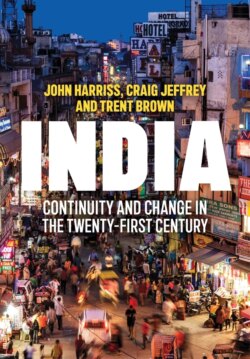Читать книгу India - Craig Jeffrey - Страница 18
Federalism
ОглавлениеThe fourth pillar of the post-independence Indian republic was that it should be a union of states, the boundaries of which were an inheritance from the colonial administration. The Congress as a national movement was successful in defining Indianness ‘not as a singular or exhaustive identity, but as one which explicitly recognized at least two other aspects. Indian citizens were also members of linguistic and cultural communities: Oriyas or Tamils, Kashmiris or Marathi’. And, ‘India’s federal arrangements were intended to embody this idea of a layered Indianness’ (Khilnani 1997: 175). These federal arrangements are reflected in the way the upper house of the Indian parliament, the Rajya Sabha, is composed mainly by members elected by the Legislative Assemblies of India’s states and Union Territories. In turn, the members of those Assemblies are themselves directly elected, and the Constitution lays down the division of powers, responsibilities and resources between the union government at the centre, and the state governments. The federal principle is relatively weak, however, and the founding fathers were greatly concerned that India should have a strong central government. The powers of the states were curtailed from the outset and the centre has considerable authority in relation to them, including the power of suspending the Legislative Assembly of a state, and of imposing President’s Rule – an instrument that has sometimes been used for entirely partisan reasons.
The states of India, as they were inherited from the administrative divisions of British India, were generally multi-lingual, and one of the challenges that the Government of India confronted in the 1950s was that of powerful demands from different parts of the country for the recognition of regional cultural groups through the creation of linguistic states. In spite of fears at the time – not least on Nehru’s part – that these demands threatened the unity of India, states reorganization did take place. The major states were generally redefined on linguistic lines (though not in the Hindi-speaking heartland of the country), without – as it turned out – endangering national unity. Over time, however, this has helped the rise of significant regional political parties, and in the period of minority and coalition governments between 1989 and 2014, regional parties sometimes exercised considerable influence on the central government. It was thought by some politicians and observers in 2019 that between them the regional parties might win a sufficient number of votes to be able to challenge the BJP in forming the government, but in the event these hopes were dashed by the comprehensive victory that the BJP secured.
The administrative capacities of the different states vary very considerably, including in their abilities to raise revenue. Article 280 of the Constitution requires the Government of India to appoint a Finance Commission every five years to advise on the financial relations between the centre and the states, and one of the problems that these Commissions have to deal with is that of achieving a workable balance between states that are relatively efficient in raising revenues and those that are not. The disparities between the major states in terms of economic and social development have tended to increase over time, and the Finance Commissions have to contend with the concerns of the more efficient states about the extent to which they may be subsidizing those that are more backward.
